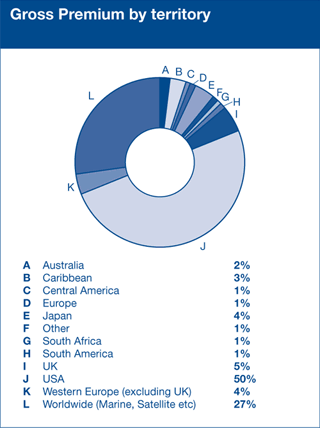Risk Disclosures
5. Amlin Bermuda
Amlin Bermuda was formed in December 2005 to directly write a short tail portfolio of reinsurance business. The direct written portfolio consists of the following classes with maximum line sizes and split by territory.

| 2006 gross premium written £m |
Current maximum line size £m |
2006 average line size £m |
|
| Catastrophe reinsurance | 136 | 75 | 6.0 |
|---|---|---|---|
| Per risk property reinsurance | 31 | 12.5 | 2.6 |
| Proportional reinsurance | 44 | 7.5 | 1.0 |
| Accident & health | 1 | 7.5 | 2.6 |
| Aviation reinsurance | 1 | 20 | 2.5 |
| Marine reinsurance | 3 | 20 | 6.0 |
| Special risks | 10 | 15 | 5.0 |
| Syndicate 2001 whole account QS | 121 | ||
| Syndicate 2001 variable QS | 53 | ||
| Syndicate 2001 catastrophe reinsurance | 12 | ||
In 2006 Amlin Bermuda’s business has strong similarities to the reinsurance portfolio of the Non-Marine Division of Syndicate 2001. All of the business written emanates from London broker markets and is frequently seasoned business already underwritten by Syndicate 2001. Necessary balance is provided by a whole account quota share of Syndicate 2001. This is further supplemented by a number of specific variable quota share treaties on short tail classes such as property and energy. These are utilised by Syndicate 2001 underwriters on an individual risk basis when deemed appropriate.
Amlin Bermuda supplied Syndicate 2001 with short term catastrophe reinsurance to alleviate pressure in peak zones while the Syndicate’s reinsurance negotiations were taking place. This maximised capital utilization while not unduly over-exposing an Amlin Bermuda that was still very much in the process of building its portfolio. These reinsurance contracts expired on 30 June 2006.
Property reinsurance is written through treaty arrangements on a proportional, individual risk excess of loss, or catastrophe excess of loss basis. The catastrophe reinsurance portfolio is a key aspect of the insurance risk written by Amlin Bermuda. Exposures to each programme are currently limited to $12.5 million per risk and $75 million any one catastrophe programme, with maximum event limits of $250 million any one zone and $300 million for losses affecting more than one zone.
Catastrophe event exposures per territory are carefully recorded and analysed through loss simulations or realistic disaster scenarios. Amlin Bermuda is exposed to the impact of large catastrophe events such as windstorms, earthquakes or terrorist incidents. Exposure to such events is controlled and measured through loss modelling but the accuracy of this exposure analysis is limited by the quality of data and the effectiveness of the modelling. The Group’s broad risk appetite guidelines are set out below. It is possible that a catastrophe event exceeds the maximum expected event loss. This is particularly the case for the direct property proportion of the loss exposure, which Amlin Bermuda would receive through the whole account and specific variable quota shares, where models are used to calculate a damage factor representing the amount of damage expected to exposed aggregate insured values. Errors or incorrect assumptions in the damage factor calculation can result in an incurred catastrophe event higher than predicted due to unforeseen circumstances. A significant element of the Amlin Bermuda book is catastrophe reinsurance relating to US windstorm however a severe catastrophe to a major economic zone in Europe, Japan or the USA is likely to result in an overall loss to the property portfolio.
The accident and health class is written through medical expense schemes in the US and provides personal accident reinsurance worldwide. Personal accident reinsurance could be impacted by a single or series of accidents to high value insured individuals or from a multiple death and injury event such as an air crash or natural catastrophe.
The special risks account includes small premium classes mostly relating to terrorism reinsurance but also includes nuclear and contingency which is written in all parts of the world.
The Bermuda subsidiary writes risks without the protection of a reinsurance programme and therefore has higher net retained exposures to individual risk losses than the Syndicate currently bears.
